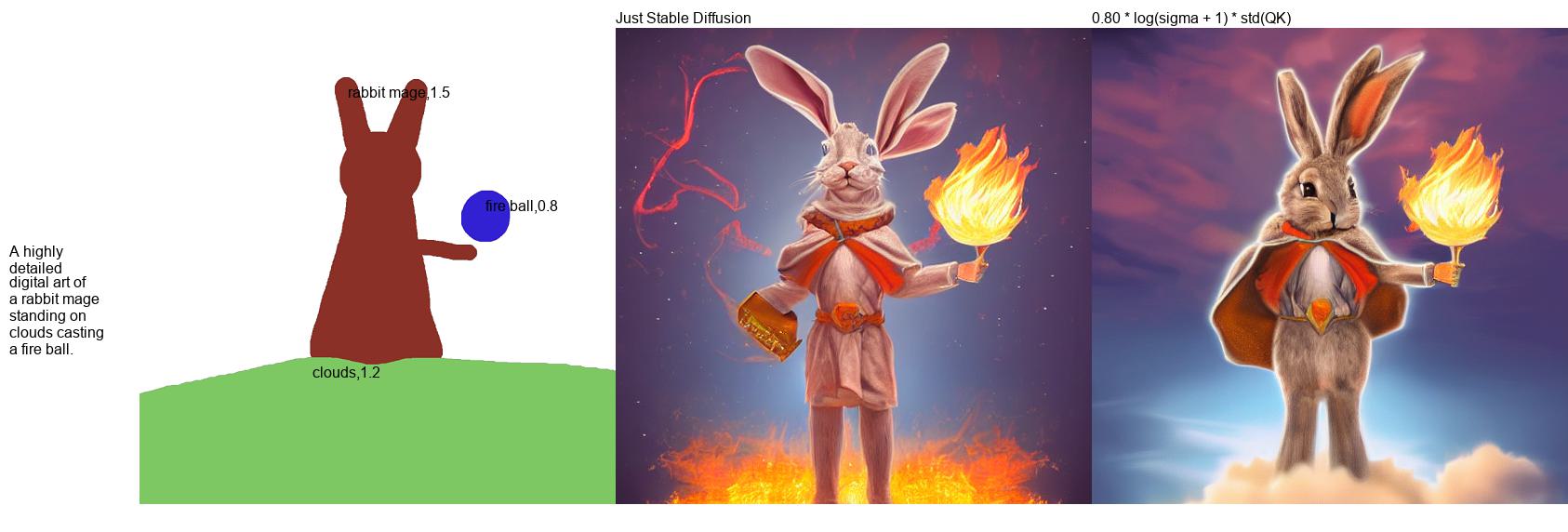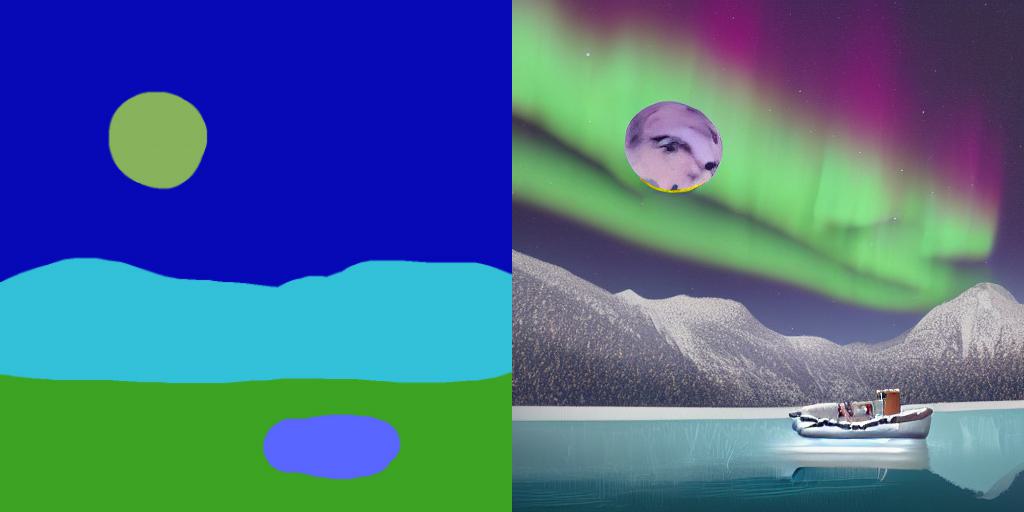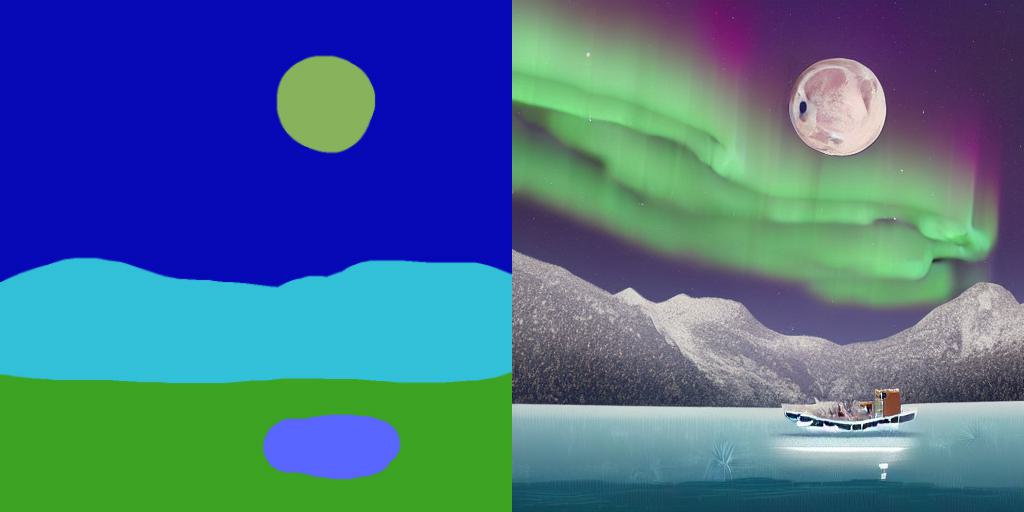Notice how without PwW the cloud is missing.
Notice how without PwW, abandoned city is missing, and road becomes purple as well.
"A digital painting of a half-frozen lake near mountains under a full moon and aurora. A boat is in the middle of the lake. Highly detailed."
Notice how nearly all of the composition remains the same, other than the position of the moon.
Recently, researchers from NVIDIA proposed eDiffi. In the paper, they suggested method that allows "painting with word". Basically, this is like make-a-scene, but with just using adjusted cross-attention score. You can see the results and detailed method in the paper.
Their paper and their method was not open-sourced. Yet, paint-with-words can be implemented with Stable Diffusion since they share common Cross Attention module. So, I implemented it with Stable Diffusion.
pip install git+https://github.com/cloneofsimo/paint-with-words-sd.gitBefore running, fill in the variable HF_TOKEN in .env file with Huggingface token for Stable Diffusion, and load_dotenv().
Prepare segmentation map, and map-color : tag label such as below. keys are (R, G, B) format, and values are tag label.
{
(0, 0, 0): "cat,1.0",
(255, 255, 255): "dog,1.0",
(13, 255, 0): "tree,1.5",
(90, 206, 255): "sky,0.2",
(74, 18, 1): "ground,0.2",
}You neeed to have them so that they are in format "{label},{strength}", where strength is additional weight of the attention score you will give during generation, i.e., it will have more effect.
import dotenv
from PIL import Image
from paint_with_words import paint_with_words
settings = {
"color_context": {
(0, 0, 0): "cat,1.0",
(255, 255, 255): "dog,1.0",
(13, 255, 0): "tree,1.5",
(90, 206, 255): "sky,0.2",
(74, 18, 1): "ground,0.2",
},
"color_map_img_path": "contents/example_input.png",
"input_prompt": "realistic photo of a dog, cat, tree, with beautiful sky, on sandy ground",
"output_img_path": "contents/output_cat_dog.png",
}
dotenv.load_dotenv()
color_map_image = Image.open(settings["color_map_img_path"]).convert("RGB")
color_context = settings["color_context"]
input_prompt = settings["input_prompt"]
img = paint_with_words(
color_context=color_context,
color_map_image=color_map_image,
input_prompt=input_prompt,
num_inference_steps=30,
guidance_scale=7.5,
device="cuda:0",
)
img.save(settings["output_img_path"])There is minimal working example in runner.py that is self contained. Please have a look!
In the paper, they used
$w' = w \log (1 + \sigma) std (Q^T K)$
$w' = w \log (1 + \sigma) \max (Q^T K)$
$w' = w \log (1 + \sigma^2) std (Q^T K)$
You can define your own weight function and further tweak the configurations by defining weight_function argument in paint_with_words.
Example:
w_f = lambda w, sigma, qk: 0.4 * w * math.log(sigma**2 + 1) * qk.std()
img = paint_with_words(
color_context=color_context,
color_map_image=color_map_image,
input_prompt=input_prompt,
num_inference_steps=20,
guidance_scale=7.5,
device="cuda:0",
preloaded_utils=loaded,
weight_function=w_f
)
$w' = w \log (1 + \sigma) std (Q^T K)$
$w' = w \log (1 + \sigma) \max (Q^T K)$
$w' = w \log (1 + \sigma^2) std (Q^T K)$
I'll work on these after school exam is over
- Make extensive comparisons for different weight scaling functions.
- Create word latent-based cross-attention generations.
- Check if statement "making background weight smaller is better" is justifiable, by using some standard metrics
- Create AUTOMATIC1111's interface
- Create Gradio interface
- Create tutorial
- See if starting with some "known image latent" is helpful. If it is, we might as well hard-code some initial latent.
- Region based seeding, where we set seed for each regions. Can be simply implemented with extra argument in
COLOR_CONTEXT - sentence wise text seperation. Currently token is the smallest unit that influences cross-attention. This needs to be fixed. (Can be done pretty trivially)
- Allow different models to be used. use this.
- "negative region", where we can set some region to "not" have some semantics. can be done with classifier-free guidance.
- Img2ImgPaintWithWords -> Img2Img, but with extra text segmentation map for better control
- InpaintPaintwithWords -> inpaint, but with extra text segmentation map for better control
- Support for other schedulers










